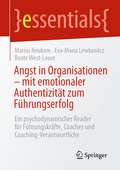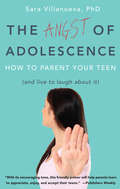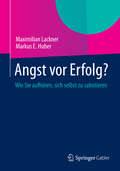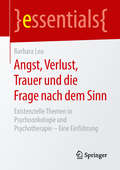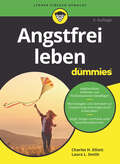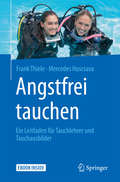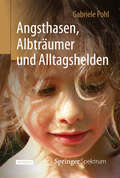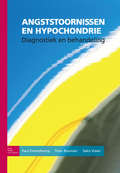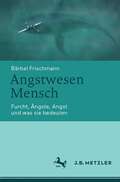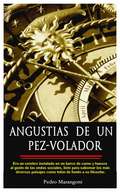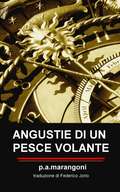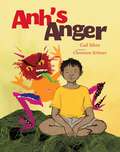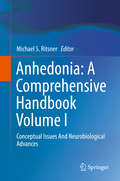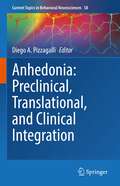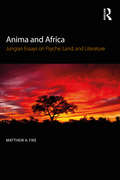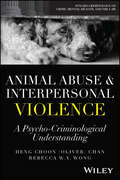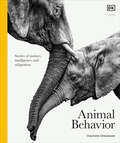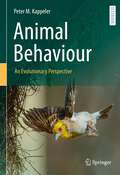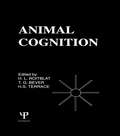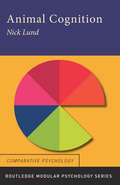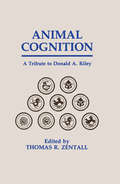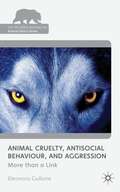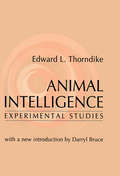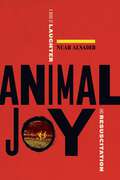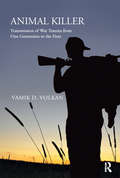- Table View
- List View
Angst in Organisationen – mit emotionaler Authentizität zum Führungserfolg: Ein psychodynamischer Reader für Führungskräfte, Coaches und Coaching-Verantwortliche (essentials)
by Eva-Maria Lewkowicz Beate West-Leuer Marius NeukomUnliebsame Gefühle sind Merkmale konstruktiv authentischen Führens. Führungskräfte, die Angst erleben und reflektieren können, verfügen über Vorteile. Denn Angst ist nicht nur ein Schlüssel zur Ausbildung von Selbstkenntnis, sondern auch zur Förderung von Motivation, Zusammenarbeit und Veränderungsbereitschaft. In der Arbeitswelt wird Angst jedoch vermieden und tabuisiert, weil sie Abneigung erzeugt und als hemmend erlebt wird. Dieser Leitfaden macht dieses essenziell menschliche Gefühl zugänglich, erläutert seine unvermeidliche, gesunde wie auch krank machende Seite und zeigt Wege auf, wie es sinnvoll und produktiv in Führungsarbeit und Organisationsentwicklung integriert werden kann.
Angst of Adolescence: How to Parent Your Teen and Live to Laugh About It
by Sara VillanuevaBeing a good parent is one of the most difficult, yet most rewarding, jobs a person can have in his or her lifetime. Being the parent of a teen is an especially daunting phase of the journey. As parents begin to notice the significant changes that come with adolescence (physical changes brought about by puberty, the constant angst and moodiness, and of course the classic eye-rolling and the I-know-it-all attitude), they wonder just what happened to their happy, sweet, and affectionate young boy or girl. Parents sit by amazed--and often lost and unprepared--as they witness their child morph and mutate into a full-blown pubescent display of emotions. The Angst of Adolescence: How to Parent Your Teen and Live to Laugh About It, written in a conversational, informative, humorous and relatable style, promises to deliver trustworthy resource for parents of teens who are searching for answers and guidance about how to maneuver their way through this tricky developmental period. Dr. Sara Villanueva, a prominent psychologist specializing in the adolescent years, shares relevant research findings so that parents can be informed of the facts as opposed to making assumptions based on ubiquitous but questionable sources. Most of all it will provide parents of teenagers with perspective in the midst of angst so they can come away with the sense that: * They are not alone in their experience of raising teens; many, many people have gone through it and we can all relate to and learn from one another. * Most of what your teen is feeling and expressing is normal and falls within the expected range of behavior for adolescent development. * Despite the challenges involved in parenting teens, we should take time to focus on the positive things in life and live with our child through the tough adolescent years so that we emerge on the other side with friendship and a deeper bond. As a psychologist and mother of four, the author shares both research-based and first-hand advice on how to navigate the teen years and live to laugh about it.
Angst vor Erfolg?: Wie Sie aufhören, sich selbst zu sabotieren
by Maximilian Lackner Markus E. HuberSie wünschen sich Erfolg - aber der will sich einfach nicht einstellen? Wenn Sie gerne erfolgreich wären, es aber Ihrer Meinung nach (noch) nicht sind, könnten Sie sich im Grunde davor fürchten und unbewusst Ihre eigenen Anstrengungen sabotieren. Immer wieder hält die meist unbewusste Furcht vor Veränderung Menschen davon ab, ihre ersehnten Ziele zu erreichen. Insbesondere die Angst vor dem Scheitern kann ihnen im Weg stehen. Dieses Buch hilft Ihnen, latente Ängste zu entlarven, sich ihnen zu stellen und sie zu überwinden. Sie erfahren, was Sie ganz konkret unternehmen können, um die angestrebten Ziele zu erreichen und wie Sie dabei Ihre eigene Erfolgsgeschichte schreiben. ". . . ein äußerst informativer und kompakt geschriebener Ratgeber, der einem hilft, die Steine des Misserfolgs, die in der eigenen Psyche oft genug den Weg versperren, beiseite zu räumen. " Mag. Adam Silye, Künstler "Sehr gründlich und gut recherchiert, ohne dabei belehrend zu wirken. Das Buch motiviert sehr, sich mit der Thematik auseinanderzusetzen und daraus für sich persönlich eine Lehre zu ziehen. " Katharina Kuhlmann, HR-Managerin
Angst, Verlust, Trauer und die Frage nach dem Sinn: Existenzielle Themen In Psychoonkologie Und Psychotherapie - Eine Einführung (Essentials)
by Barbara LeuEine Krebsdiagnose wirft die meisten Menschen aus der Bahn und bedeutet einen tiefen und bedrohlichen Einschnitt in ihr eigenes Leben, aber auch dasjenige ihrer Angehörigen. Die Erkenntnis, dass das Leben endlich und prekär ist, kann existenzielle Ängste, tiefe Trauer und Fragen nach dem Sinn auslösen, geht es ja letztlich um die Fragen nach Sterben und Tod. Wie können involvierte Fachpersonen mit diesen letzten Fragen der „conditio humana“ umgehen, wie können sie, trotz eigener Betroffenheit, angesichts dieser existenziellen Herausforderungen tragend und hilfreich sein? Diesen Fragen geht die vorliegende Publikation mit theoretischen Inputs sowie praktischen Vorschlägen für den Aufbau einer existenziellen Grundhaltung erfolgreich nach.Die Autorin Barbara Leu ist Psychotherapeutin (systemisch und existenzielle Ausrichtung) und Psychoonkologin am Kantonsspital Aarau, Schweiz. Daneben arbeitet sie als Psychotherapeutin in einer psychiatrisch/psychologischen Gemeinschaftspraxis in Zürich, Schweiz.
Angstfrei leben für Dummies (Für Dummies)
by Laura L. Smith Charles H. ElliottViele Menschen leiden unter à ngsten - sei es Platzangst, Flugangst, Angst vor Zurückweisung, Angst vor dem Verlust des Partners oder Kindes oder Angst vor dem Verlust des Arbeitsplatzes. So unterschiedlich diese à ngste sind, eines haben sie gemeinsam: Sie beeinträchtigen das Leben der Betroffenen und ihrer Angehörigen enorm. »Angstfrei leben für Dummies« hilft mit Selbsttests und einfachen à bungen, einen Weg aus dem Teufelskreis von Angst und Sorgen zu finden. Dieser Ratgeber zeigt, wie Sie Ihren à ngsten Schritt für Schritt begegnen können und wie Sie sie schlieà lich überwinden und sich nicht mehr von ihnen beherrschen lassen.
Angstfrei tauchen: Ein Leitfaden für Tauchlehrer und Tauchausbilder
by Frank Thiele Mercedes HuscsavaPanik unter Wasser? Ein Alptraum f#65533;r Tauchsch#65533;ler und Tauchlehrer. Damit dies nicht geschieht, liefert das vorliegende Buch Tauchlehrern und Tauchausbildern wertvolle Informationen, wie man Stress oder #65533;ngsten bei Tauchsch#65533;lern erfolgreich begegnet. Die Autoren erl#65533;utern das menschliche Verhalten dabei sowohl aus wissenschaftlicher Sicht, also ,,Warum haben wir Angst?", oder ,,Wie entsteht Angst #65533;berhaupt?" und geben gleichzeitig zahlreiche Tipps, die in einer Akutsituation helfen - vor oder w#65533;hrend des Tauchgangs. Auch auf die Besonderheiten beim Tauchen mit Kindern in den verschiedenen Altersgruppen geht das Werk ein.
Angsthasen, Albträumer und Alltagshelden
by Gabriele PohlDieses Buch schildert anschaulich die Entängstigungsstrategien von Kindern. Anhand von zahlreichen Beispielen und gespielten Geschichten von Kindern in der Therapie verdeutlicht die Autorin, wie Kinder ihre Ängste durch das freie Spiel verarbeiten. Sie zeigt auf, wie klug das Unterbewusstsein des Kindes Lösungsmöglichkeiten bereit hält und ,,weiß" welcher nächste Entwicklungsschritt ansteht. Dabei wird der Leser mit wunderbaren, poetischen Märchenbildern beschenkt, die aus der Imaginationskraft der Kinder gespeist sind. Lassen Sie sich ein auf diese Entdeckungsreise, denn dadurch kann der Blick für die wirklichen Bedürfnisse von Kindern geschärft werden. Eltern und Pädagogen erhalten darüber hinaus ein besseres Verständnis für die Symbolsprache des Spielens.
Angststoornissen en hypochondrie: Diagnostiek en behandeling
by P. M. G. Emmelkamp T. K. Bouman S. VisserAngststoornissen en hypochondrie is een actueel overzichtswerk, waarin op praktische wijze inzicht gegeven wordt in de classificatie (volgens de DSM-IV-TR-criteria), diagnostiek, etiologie en behandeling van angststoornissen en hypochondrie. Bij de behandeling van deze stoornissen wordt, naast een bespreking van farmacotherapie, met name aandacht besteed aan recente ontwikkelingen in de cognitieve therapie en gedragstherapie. Er zijn door de jaren heen vorderingen gemaakt op het gebied van research die implicaties hebben voor de diagnostiek en behandeling van deze stoornissen. Angststoornissen en hypochondrie gaat uitvoerig in op de problemen die zich bij het uitvoeren van de behandeling kunnen voordoen. Bovendien wordt in heldere taal een genuanceerd beeld van de huidige stand van zaken in onderzoek en theorievorming weergegeven. Het boek is voorzien van gevalsbeschrijvingen. De hoofdstukken over behandeling gaan met name uit van (cognitieve) gedragstherapeutische principes vanwege de belangrijke resultaten die daarmee geboekt zijn in de behandeling van angststoornissen en hypochondrie. Daarnaast wordt per stoornis steeds een overzicht geboden van recent onderzoek naar de behandeling met psychofarmaca. Angststoornissen en hypochondrie is een geheel herziene en geactualiseerde druk van het boek Angst, fobieën en dwang. Angststoornissen en hypochondrie is bedoeld voor psychologen, psychiaters, huisartsen, maatschappelijk werkenden en opleidingen voor deze beroepen.
Angstwesen Mensch: Furcht, Ängste, Angst und was sie bedeuten
by Bärbel FrischmannAngst begleitet uns überallhin und jederzeit. Sie gehört zum Menschen. Der Mensch ist ein Angstwesen, und dies prägt sein Verhältnis zur Welt, zu anderen und zu sich selbst. Um die Bedeutung der verschiedenen Ängstigungsweisen zu erläutern, wird eine Unterscheidung von drei Grundfunktionen, affektive Furcht, gefühlte Ängste und geistige Angst, vorgeschlagen. Sie stellen jeweils spezifische Ausprägungen der überlebenswichtigen Gefahrenbewältigung dar, die beim Menschen nicht nur die körperliche Schutzfunktion umfasst, sondern auch durch gedankliche Antizipation möglicher Risiken und Bedrohungen geprägt ist. Aber vor allem die Angstgefühle können aus dem Gleichgewicht geraten, als leidvoll erlebt werden und sogar pathologisch werden. Deshalb soll am Ende auch die Hoffnung formuliert werden, dass Menschen die geistige Kraft besitzen, ihre Ängste sinnvoll in ihr Leben einzuordnen. Für eine differenzierte Sicht auf die Thematik werden zum einen einschlägige Theorien von Biologie über Psychologie bis Soziologie und Philosophie herangezogen, zum anderen die gewonnenen Ergebnisse mit Blick auf gesellschaftliche, politische und ideologisch-weltanschauliche Anwendungsbereiche vertieft.
Angustias de un pez-volador
by Pedro MarangoniEl más patético de los animales, el Hombre-pez-volador, en este salto de un segundo de consciencia transitoria colecciona todo lo que puede acopiar, plumas al viento, granos de polvo, alguna hoja que quizás esté flotando en la superficie. Se tropieza con el pez que salta al lado, toma la iniciativa. Y después se disuelve en el agua con algunas salpicaduras que rápidamente desaparecen. Si en el micro momento antes de tocar con la cabeza el océano de la Nada, preguntáramos el color del maravilloso cielo que acababa de recorrer, no sabría la respuesta... ... Transitoriedad es la palabra que mejor definía a Arturo, porque así se sentía: un ser pasando de una forma a otra. Viajando como un pez-volador que había nacido cuando comenzaba a salir del agua para su salto y que, momentos después, caería nuevamente en la inconsciencia cuando volviera a tocar la superficie límpida, tranquila, indiferente de un mar infinito llamado Universo. Sabía que en esta reentrada por más que se agitara, sólo provocaría algunas salpicaduras que pronto desaparecerían.
Angustie di un pesce volante
by Pedro Marangoni Federico JorioIl più patetico tra gli animali, l’Uomo-pesce volante, in questo salto di un secondo di coscienza transitoria colleziona tutto quanto può racimolare, piume di penna al vento, granelli di polvere, foglie che, casualmente, galleggiasse sulla superficie. Si lancia sul pesce che salta al suo fianco, prendendo l’iniziativa. E dopo scompare in mare, creando schizzi che rapidamente si dissolvono. Se, nel micro momento prima che la testa impatti con l’oceano del Nulla, gli domandassimo il colore del meraviglioso cielo che ha appena terminato di percorrere, non conoscerebbe la risposta…Transitorietà è la parola che ben definiva Arthur, perché si sentiva così: un essere che passava da una forma all’altra. Si vedeva come un pesce volante che nacque quando cominciò ad uscire dall’acqua per il suo salto e che, dopo alcuni istanti, sarebbe ricaduto nuovamente nell’incoscienza, allorché tornava a toccare la superficie limpida, tranquilla, indifferente di un mare infinito chiamato Universo. Sapeva che in questo rientro, per quanto si agitasse, avrebbe creato degli schizzi, che si sarebbero dissolti subito dopo. Sapeva di essere tutto e nulla allo stesso tempo, giacché era fatto di Arthur, di pietre, d’alberi, d’acqua e di tutto il resto di cui era composto il Tutto, pezzi intercambiabili che costruivano il caso. E il caso dotò Arthur di una qualità dubbiosa, quella di far uso di una coscienza transitoria, di vedersi e sentirsi, di osservare, in questo salto millimetrico ed effimero. Era un povero essere umano, il più inutile delle creature in una realtà ugualmente inutile.
Anh's Anger: An Anh's Anger Story (Anh's Anger Story)
by Christiane Krömer Gail SilverChildren experience anger on a regular basis, but lack the coping skills to guide them through these difficult moments. In Anh's Anger, five-year-old Anh becomes enraged when his grandfather interrupts playtime with a summons to the dinner table. When Anh's grandfather takes the time to help Anh fully experience his anger by suggesting he go to his room and "sit with his anger," Anh discovers a positive method by which to work through his feelings. This remarkable book teaches children to both acknowledge and resolve their difficult emotions, making it an invaluable tool for parents and teachers alike.
Anhedonia: Conceptual Issues And Neurobiological Advances
by Michael S. RitsnerThis is the first comprehensive two-volume collection on anhedonia, a disorder that played an important role in psychopathology theories at the beginning of the twentieth century. Anhedonia is a condition in which the capacity of pleasure is partially or completely lost, and it refers to both a personality trait, and a "state symptom" in various neuropsychiatric and physical disorders. It has a putative neural substrate, originating in the dopaminergic mesolimbic and mesocortical reward circuit. Over the past three decades cognitive psychology and behavioral neuroscience have expanded our understanding of anhedonia and other reward-related processes. The aim of this new two-volume collection on anhedonia is to highlight the contributions of eminent scientists in this field as well as to provide readers with comprehensive accounts of recent developments as perceived by the authors. This monograph is divided into five parts. Volume I contains parts one and two (Conceptual Issues and Neurobiological Advances) including 14 chapters that serve as an introduction and overview of conceptual issues. Volume II contains three parts (Anhedonia in Psychotic Disorders, Anhedonia in Mood and Personality Disorders, and Anhedonia in Neurological and Physical Disorders) including 15 chapters that provide an overview of the construct, measurement of anhedonia in schizophrenia spectrum disorders, hedonic capacity and related factors in schizophrenia and schizoaffective disorder, anhedonia as an indicator of genetic liability for schizophrenia, and as a trait marker for depression, the role of an anhedonia in trauma-related disorders, anorexia nervosa, stress-induced eating disorders, schizotypal traits and risk of suicide. This book will be of interest to a broad spectrum of readers including psychiatrists, psychologists, neurologists, neuroscientists, endocrinologists, pharmacologists, general practitioners, geriatricians, graduate students, and health care providers in the fields of mental health.
Anhedonia: Preclinical, Translational, and Clinical Integration (Current Topics in Behavioral Neurosciences #58)
by Diego A. PizzagalliAnhedonia is a key symptom (and often risk factor) for various neuropsychiatric disorders, including depression, schizophrenia, substance use disorders, post-traumatic stress disorders, and Parkinson's Disease, among others. Across disorders, anhedonia has been associated with worse disease course, including poor response to pharmacological, psychological and neurostimulation treatments as well as completed suicide. Mounting evidence emerging from preclinical and translational sciences has clarified that "anhedonia" can be parsed into partially independent subcomponents, including incentive motivation, consummatory pleasure, reward learning, and effort-based decision making, pointing to distinct neurobiological substrates that could underlie anhedonic phenotypes. Taking an integrative approach that emphasizes cross-species integration and dimensional conceptualization of mental illnesses (e.g., Research Domain Criteria (RDoC)), this book represents the most comprehensive evaluation, synthesis and integration of theories and empirical findings focused on anhedonia.Organized across five parts, the handbook starts with chapters on the history, etiology, and assessments of anhedonia (Part I), followed by a section on the role of anhedonia in psychiatric and neurological disorders (Part II). Using the RDoC Matrix as a guide, Part III presents chapters synthetizing preclinical and clinical findings on different reward processing subdomains (e.g., reward responsiveness, reward valuation, reward learning). Part IV is focused on selected special topics, including historical and current perspectives on the transdiagnostic nature and importance of social anhedonia, the role of inflammation in the pathophysiology of anhedonia, the use of computational modeling to “dissect” anhedonia and improve its understanding, and links between anhedonia and suicide. Finally, Part V includes chapters on pharmacological, psychological and neurostimulation treatments for anhedonia.
Anima and Africa: Jungian Essays on Psyche, Land, and Literature
by Matthew A. FikeC. G. Jung understood the anima in a wide variety of ways but especially as a multifaceted archetype and as a field of energy. In Anima and Africa: Jungian Essays on Psyche, Land, and Literature, Matthew A. Fike uses these principles to analyze male characters in well-known British, American, and African fiction. Jung wrote frequently about the Kore (maiden, matron, crone) and the "stages of eroticism" (Eve, Mary, Helen, Sophia). The feminine principle’s many aspects resonate throughout the study and are emphasized in the opening chapters on Ernest Hemingway, Henry Rider Haggard, and Olive Schreiner. The anima-as-field can be "tapped" just as the collective unconscious can be reached through nekyia or descent. These processes are discussed in the middle chapters on novels by Laurens van der Post, Doris Lessing, and J. M. Coetzee. The final chapters emphasize the anima’s role in political/colonial dysfunction in novels by Barbara Kingsolver, Chinua Achebe/Nadine Gordimer, and Aphra Behn. Anima and Africa applies Jung’s African journeys to literary texts, explores his interest in Haggard, and provides fresh insights into van der Post’s late novels. The study discovers Lessing’s use of Jung’s autobiography, deepens the scholarship on Coetzee’s use of Faust, and explores the anima’s relationship to the personal and collective shadow. It will be essential reading for academics and scholars of Jungian and post-Jungian studies, literary studies, and postcolonial studies, and will also appeal to analytical psychologists and Jungian psychotherapists in practice and in training.
Animal Abuse and Interpersonal Violence: A Psycho-Criminological Understanding (Psycho-Criminology of Crime, Mental Health, and the Law)
by Heng Choon Oliver Chan Rebecca W. Y. WongANIMAL ABUSE & INTERPERSONAL VIOLENCE A COMPREHENSIVE EXAMINATION OF THE CAUSES OF, AND LINKS BETWEEN, INTERPERSONAL AND INTERSPECIES VIOLENCE Animal Abuse & Interpersonal Violence: A Psycho-Criminological Understanding addresses the many aspects of the link between animal cruelty and human violence. Presenting new theory, research, policy, and practice, this authoritative volume explores the subject through a psycho-criminological lens to describe, explain, and potentially prevent intentional behavior that causes pain, suffering, or death in animals and humans. With an integrated theoretical-practical approach, Animal Abuse & Interpersonal Violence offers up-to-date research and provides real-world insights into current thinking in the study of animal abuse and interpersonal violence. Sixteen in-depth chapters by a multidisciplinary team of active researchers and experienced field practitioners examine central topics in the field, including different forms of animal exploitation, connections between animal cruelty and substance abuse, the association between childhood animal cruelty and adult interpersonal violence, the role of veterinarians in the identification of animal abuse cases, the complex legal aspects of animal abuse cases, and more. Advances scholarship on animal abuse, its relationship with interpersonal violence, and the psycho-criminological mechanisms involved in that relationship Introduces readers to contemporary research on a range of topics and issues related to animal abuse and interpersonal violence Examines the origins of animal cruelty, its societal implications, and various prevention and treatment approaches Defines and describes various types of animal maltreatment and their links to different forms of interpersonal violence Animal Abuse & Interpersonal Violence: A Psycho-Criminological Understanding is essential reading for practitioners, researchers, scholars, and advanced students in fields such as behavioral science, law, criminology, veterinary forensics, criminal justice, law enforcement, social work, sociology, social sciences, education, and animal welfare.
Animal Behavior: Life in the Wild (DK Definitive Visual Encyclopedias)
by DKA thrilling face-to-face encounter with animals in their own environment—their elaborate displays, intimate lives, and extraordinary behavior. Did you know that elephants give each other names, orangutans self-medicate, and rats giggle? Animal Behavior is full of hundreds of stories that shed light on how animals navigate life in the wild. Packed with vivid wildlife photography and action sequences, every aspect of animal life and behavior is explored and explained – from courtship rituals and birth to hunting and death. An initial overview of animal anatomy and physiology reveals the science and biomechanics that underpin animal behavior, while later chapters thematically break down the intricacies of animal feeding, development, communication, intelligence, learning, and other behavioral characteristics. Learn about play through river otters, see socialization among parrots at the riverbank, and catch prey with a fishing spider. Feature panels throughout the book explore the biology behind these traits, introduce case studies from the field, and highlight critical conservation issues facing these animals. Animal Behavior has been created in collaboration with internationally renowned zoologist and TV presenter Charlotte Uhlenbroek and a team of wildlife experts to ensure up-to-date and accurate information.
Animal Behaviour: An Evolutionary Perspective
by Peter M. KappelerThis textbook presents all basic principles of animal behaviour in a clear and concise manner and illustrates them with up-to-date examples. Emphasis is placed on behavioural biology as an integrative discipline of organismic biology, focusing on the adaptive value of behaviours that facilitate resource access, predator avoidance and reproductive success and underlie parental care, all within a comprehensive presentation of social complexity. This new textbook provides a rich resource for students (and teachers) from a wide range of life science disciplines.
Animal Cognition (Comparative Cognition and Neuroscience Series)
by H. L. Roitblat H. S. Terrace T. G. BeverFirst published in 1984. With this volume we initiate a series of books in comparative cognition and neuroscience. The presentations at the Harry Frank Guggenheim Conference, June 2-4, 1982, out of which the present volume grew, showed that this field of enquiry into cognitive functioning and its neural basis had reached maturity.
Animal Cognition (Routledge Modular Psychology)
by Nick LundAnimal Cognition looks at how non-human animals process information from their environment. Nick Lund has written an accessible and engaging account of this area of comparative psychology. The book contains chapters on animal navigation (including homing behaviour and migration), animal communication methods and research into animal language, and attempts to teach language to non-human animals. A chapter on memory includes models of memory in non-human animals and discusses the importance of memory in navigation and foraging behaviour.Animal Cognition is designed to cover the AQA(A) A2 level specification but will also be of interest to undergraduates new to comparative psychology. It is well illustrated and includes a study aids section with examination questions and answers, and key research summaries.
Animal Cognition: A Tribute To Donald A. Riley (Comparative Cognition and Neuroscience Series)
by Thomas R. ZentallPrepared as a tribute to Donald A. Riley, the essays that appear here are representative of a research area that has loosely been classified as animal cognition -- a categorization that reflects a functionalist philosophy that was prevalent in Riley's laboratory and that many of his students absorbed. According to this philosophy, it is acceptable to hypothesize that an animal might engage in complex processing of information, as long as one can operationalize evidence for such a process and the hypothesis can be presented in the context of testable predictions that can differentiate it from other mechanisms. The contributions to this volume represent the three most important areas of research in animal cognition -- stimulus representation, memory processes, and perceptual processes -- although current research has considerably blurred these distinctions.
Animal Cruelty, Antisocial Behaviour and Aggression
by Eleonora GulloneDemonstrating that animal cruelty behaviours are another form of antisocial behaviour, alongside human aggression and violence, and almost without exception are carried out by the same individuals this book offers clear recommendations for future research on animal cruelty and future action aimed at prevention.
Animal Intelligence: Experimental Studies
by Edward ThorndikeAnimal Intelligence is a consolidated record of Edward L. Thorndike's theoretical and empirical contributions to the comparative psychology of learning. Thorndike's approach is systematic and comprehensive experimentation using a variety of animals and tasks, all within a laboratory setting. When this book first appeared, it set a compelling example, and helped make the study of animal behavior very much an experimental laboratory science.This landmark study in the investigation of animal intelligence illustrates Thorndike's thinking on the evolution of the mind. It includes his formal statement of the influential law of effect, which had a significant impact on other behaviorists. Hull's law of primary reinforcement was closely related to the law of effect and Skinner acknowledged that the process of operant conditioning was probably that described in the law of effect.The new introduction by Darryl Bruce is an in-depth study of Thorndike's legacy to comparative psychology as well as a thorough retrospective review of Animal Intelligence. He includes a biographical introduction of the behaviorist and then delves into his theories and work. Among the topics Bruce covers with respect to Thorndike's studies are the nature of animal intelligence, the laws of learning and connectionism, implications for comparative psychology, and relation to theories of other behaviorists. Animal Intelligence is an intriguing analysis that will be of importance to psychologists and animal behaviorists.
Animal Joy: A Book of Laughter and Resuscitation
by Nuar AlsadirA Time Must-Read Book of 2022 A Publishers Weekly Best Book of 2022Aster(ix) Journal's 12 Best Nonfiction Books of 2022An invigorating, continuously surprising book about the serious nature of laughter.Laughter shakes us out of our deadness. An outburst of spontaneous laughter is an eruption from the unconscious that, like political resistance, poetry, or self-revelation, expresses a provocative, impish drive to burst free from external constraints. Taking laughter’s revelatory capacity as a starting point, and rooted in Nuar Alsadir’s experience as a poet and psychoanalyst, Animal Joy seeks to recover the sensation of being present and embodied. Writing in a poetic, associative style, blending the personal with the theoretical, Alsadir ranges from her experience in clown school, Anna Karenina’s morphine addiction, Freud’s un-Freudian behaviors, marriage brokers and war brokers, to “Not Jokes,” Abu Ghraib, Frantz’s negrophobia, smut, the Brett Kavanaugh hearings, laugh tracks, the problem with adjectives, and how poetry can wake us up. At the center of the book, however, is the author’s relationship with her daughters, who erupt into the text like sudden, unexpected laughter. These interventions—frank, tender, and always a challenge to the writer and her thinking—are like tiny revolutions, pointedly showing the dangers of being severed from one’s true self and hinting at ways one might be called back to it.A bold and insatiably curious prose debut, Animal Joy is an ode to spontaneity and feeling alive.
Animal Killer: Transmission of War Trauma From One Generation to the Next
by Vamik D. VolkanA psychoanalytic process from its beginning to its termination is described to illustrate crucial technical issues in the treatment of individuals with narcissistic personality organization and the countertransference manifestations such patients stimulate in the analyst. The subject of this book exhibited cruelty to confirm and stabilize his grandiosity. His internal world was a "reservoir" of the deposited image of his father figure, an individual most severely traumatized during World War II. The patient was given the task to be a mass-"killer" of animals instead of being a hunted one.This book most clearly illustrates how the transgenerational transmission of trauma takes place and how the impact of war continues in future generations. The book also provides an understanding of a special kind of psychological motivation that directs a person to use weapons for mass killing. In this era of pluralism in psychoanalysis, providing the story of a psychoanalytic case in its duration opens ways for comparison and discussion of technique and can be used as a teaching tool.
